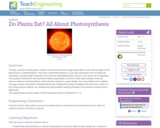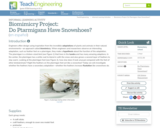
In this activity, students will test whether the color of a material affects how much heat it absorbs.
- Subject:
- Physics
- Science
- Material Type:
- Activity/Lab
- Provider:
- TeachEngineering
- Provider Set:
- TeachEngineering
- Date Added:
- 09/18/2014

In this activity, students will test whether the color of a material affects how much heat it absorbs.

This video is a short overview of The Do More Ag Foundation. The Do More Ag Foundation focuses on mental health in agriculture across Canada. They recognize the intense pressures that those in the agriculture industry face. They are committed to providing help and resources wherever possible.
https://www.domore.ag/

The Do More Ag Foundation focuses on mental health in agriculture across Canada. They are committed to providing help and resources for those in the agriculture sector. This website is a good resource when discussing mental health support in agriculture.

Through a teacher-led discussion, students realize that the food energy plants obtain comes from sunlight via the plant process of photosynthesis. They learn what photosynthesis is, at an age-appropriate level of detail and vocabulary, and then begin to question how we know that photosynthesis occurs, if we can't see it happening. Elodea is a common water plant that students can use to directly observe evidence of photosynthesis. When Elodea is placed in a glass beaker near a good light source, bubbles of oxygen will be released as products of photosynthesis. By counting the number of bubbles that rise to the surface in a five-minute period, students can compare the photosynthetic activity of Elodea in the presence of high and low light levels.

Students learn about the amazing adaptations of the ptarmigan to the alpine tundra. They focus one adaptation, the feathered feet of the ptarmigan, and ask whether the feathers serve to only keep the feet warm or to also provide the bird with floatation capability. They create model ptarmigan feet, with and without feathers, and test the hypothesis on the function of the feathers. Ultimately, students make a claim about whether the feathers provide floatation and support this claim with their testing evidence.

Students learn about biomimicry and the engineering design process as they design and build model ptarmigan feet.

Sir Ken Robinson makes an entertaining and profoundly moving case for creating an education system that nurtures (rather than undermines) creativity. Creativity expert Sir Ken Robinson challenges the way we're educating our children. He champions a radical rethink of our school systems, to cultivate creativity and acknowledge multiple types of intelligence.

These word problems address common errors that students make when adding fractions.

This problem allows the student to think geometrically about lines and then relate this geometry to linear functions. Or the student can work algebraically with equations in order to find the explicit equation of the line through two points (when that line is not vertical).

This task is designed as a follow-up to the task F-LE Do Two Points Always Determine a Linear Function? Linear equations and linear functions are closely related, and there advantages and disadvantages to viewing a given problem through each of these points of view. This task is intended to show the depth of the standard F-LE.2 and its relationship to other important concepts of the middle school and high school curriculum, including ratio, algebra, and geometry.

This problem complements the problem ``Do two points always determine a linear function?''

"Do Yoga with Me is one of my personal favourite sources for good home workouts, obviously of the yoga variety! Many of their classes are filmed outdoors in beautiful British Columbia, Canada. The level of instruction is top-notch and there are videos that focus on pretty much every part of the body (e.g. hips, hamstrings, back, etc.), so you can target the area that you need to work on most."
Any video with a plus symbol in an orange/yellow circle requires a subscription but all others are free to access. You can use the filters at the top of the page to filter your search.

This task requires students to use the normal distribution as a model for a data distribution. Students must use given means and standard deviations to approximate population percentages. There are several ways (tables, graphing calculators, or statistical software) that students might calculate the required normal percentages. Depending on the method used, answers might vary somewhat from those shown in the solution.

In this activity, students squeeze a tennis ball to demonstrate the strength of the human heart. Working in teams, they think of ways to keep the heart beating if the natural mechanism were to fail. The goal of this activity is to get students to understand the strength and resilience of the heart.

Students explore the concept of optical character recognition (OCR) in a problem-solving environment. They research OCR and OCR techniques and then apply those methods to the design challenge by developing algorithms capable of correctly "reading" a number on a typical high school sports scoreboard. Students use the structure of the engineering design process to guide them to develop successful algorithms. In the associated activity, student groups implement, test and revise their algorithms. This software design lesson/activity set is designed to be part of a Java programming class.

This is an online lesson which introduces the concept of astronomical filters and their connections to imaging different objects in space. Learners will explore perceptions of images as seen using different colors of light, construct a filter wheel, and practice investigating various astronomical images using the filter wheel. This material was designed to highlight how filters are useful to astronomers and show how a real astronomical telescope uses filters to image the Sun.

Students work with specified materials to create aqueduct components that can transport two liters of water across a short distance in their classroom. The design challenge is to create an aqueduct that can supply Aqueductis, a (hypothetical) Roman city, with clean water for private homes, public baths and fountains as well as crop irrigation.

The purpose of the task is to analyze a plausible real-life scenario using a geometric model. The task requires knowledge of volume formulas for cylinders and cones, some geometric reasoning involving similar triangles, and pays attention to reasonable approximations and maintaining reasonable levels of accuracy throughout.

Students will analyze a photograph to learn about body image. They will also discuss how society views the human body in different cultures.

Students will learn about the juxtaposition of image and text to define the social and psychological mood of the civil rights movement in the United States.